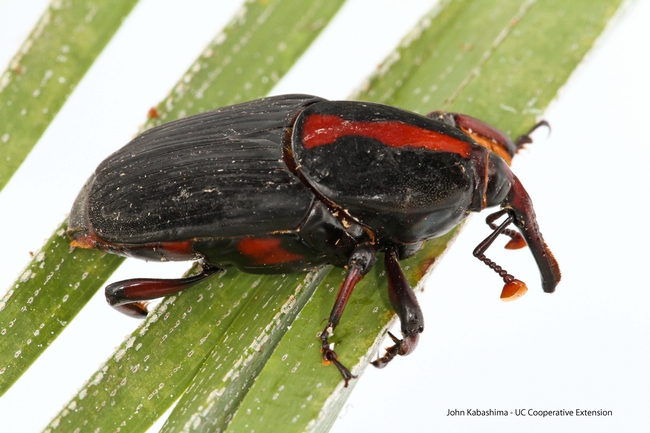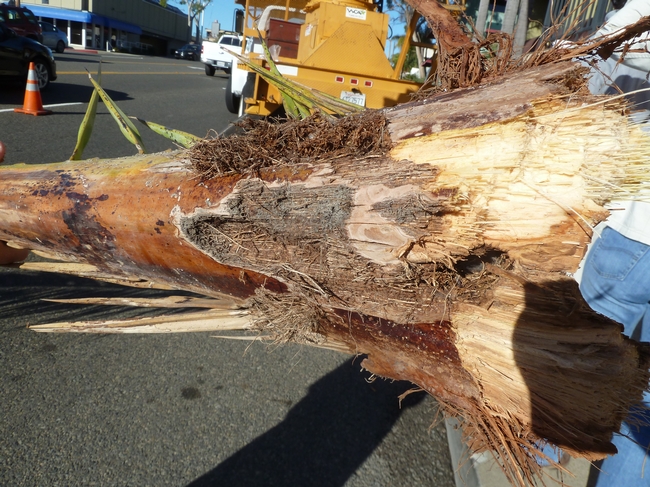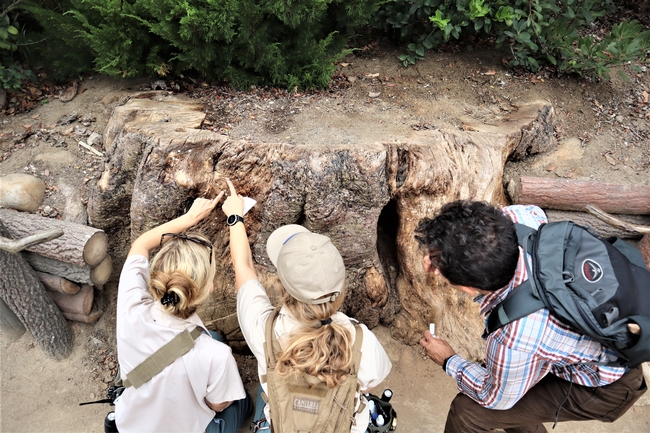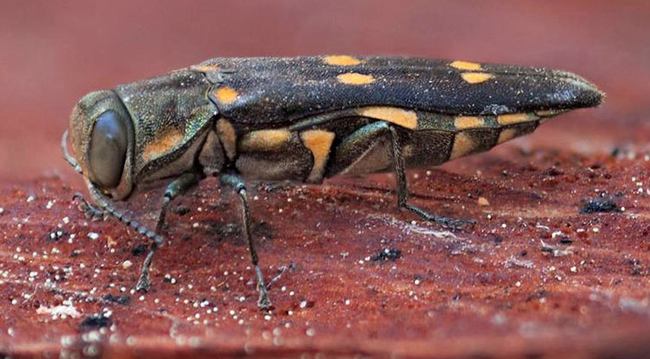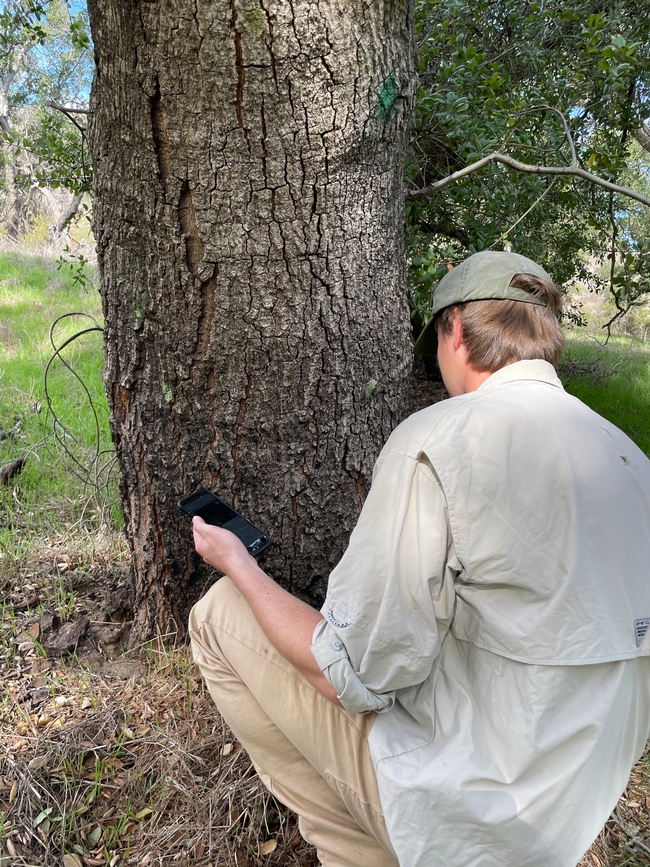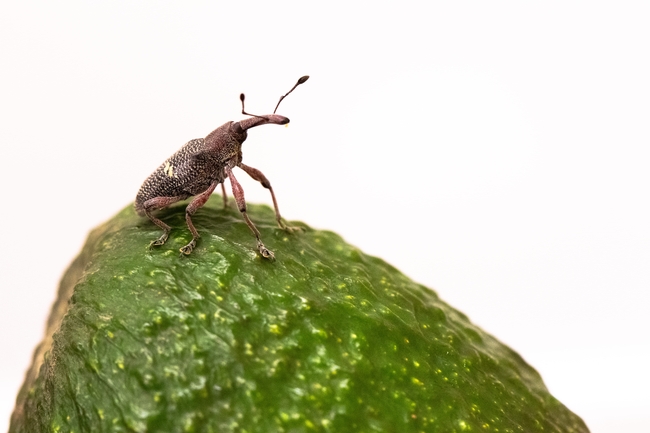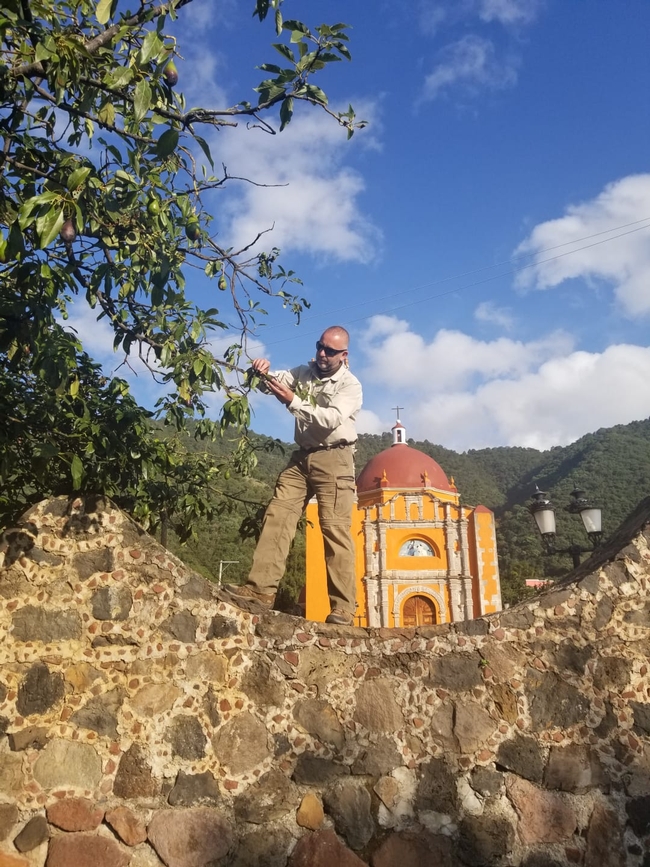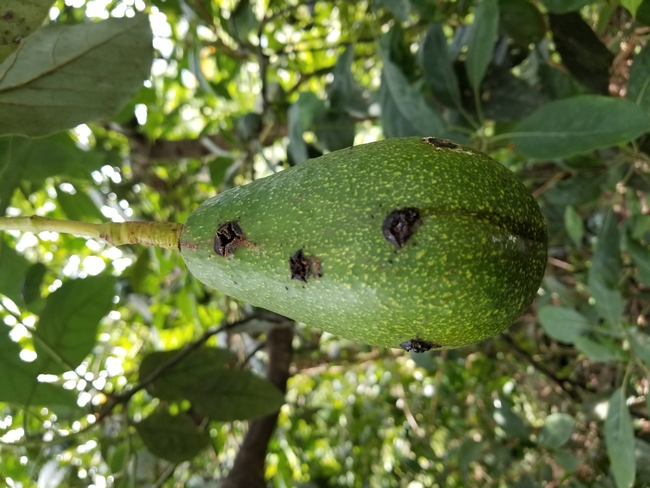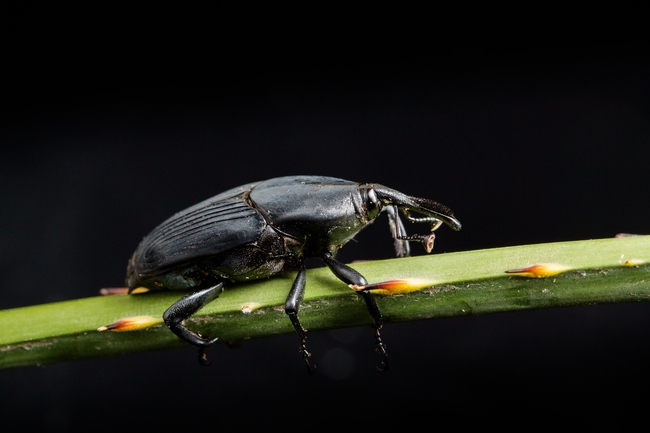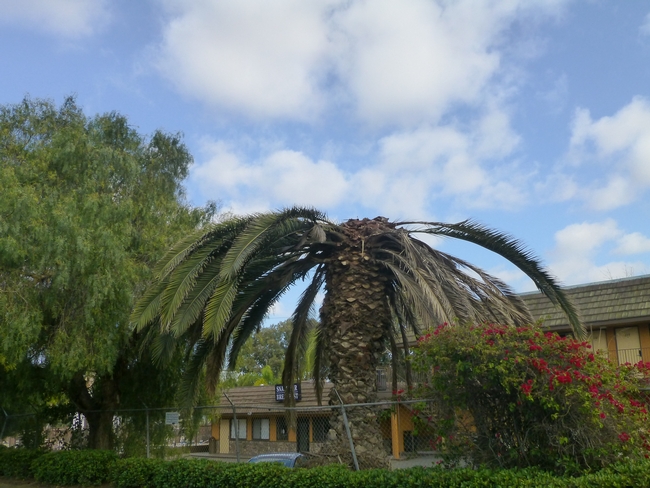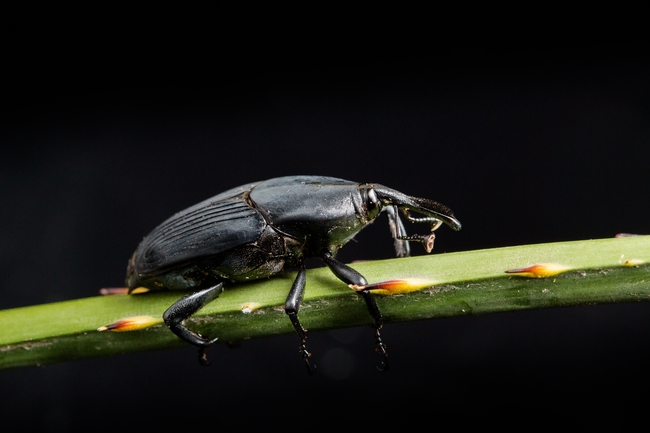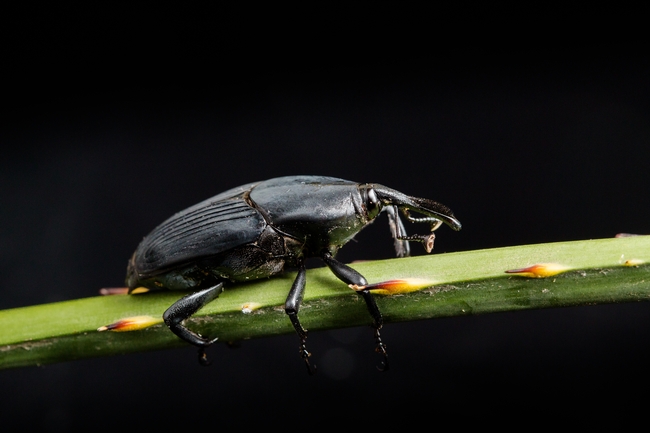Posts Tagged: weevil
Invasive pests kill thousands of trees, but scientists see some successes
Early detection increases the chances of eradicating pests
Trees provide shade to keep us cool, produce oxygen for us to breathe and calm our nerves. Numerous studies have demonstrated that even brief contact with trees and green spaces can provide significant human health benefits such as reductions in blood pressure and stress-related hormones. Trees also reduce noise and visual pollution, help manage storm water runoff, reduce erosion and provide habitat for birds and wildlife. Trees naturally capture carbon, helping to offset the forces of climate change. They also increase the value of our properties and communities. In short, trees are essential to our well-being.
Unfortunately, invasive pests pose an ongoing threat to California's forests in both urban and wildland settings. Invasive insects such as goldspotted oak borer and invasive shothole borers have killed hundreds of thousands of trees in Southern California and are continuing to spread. Meanwhile, other pests and diseases such as Mediterranean oak borer and sudden oak death are killing trees in Northern California.
While the situation may sound dire, it is not hopeless. Of course, the best way to stop invasive pests is to prevent them from entering the state, as the California Department of Food and Agriculture has done on many occasions. For example, several months ago, CDFA border inspectors seized a load of firewood containing spotted lanternfly eggs (a pest that is causing extensive damage on the East Coast). When pests do sneak in, the next defense is to catch them early before they become established. Finally, even if pests do become established, they can be managed if not completely eradicated.
A few examples may help to illustrate why invasive tree pests deserve action, but not panic.
Red striped palm weevil eradicated in Laguna Beach
When red striped palm weevil, a highly destructive palm pest native to Indonesia, was discovered in Laguna Beach in October 2010, a working group was quickly formed to develop a management plan. The small but diverse group included international palm weevil experts, research scientists from University of California Riverside, CDFA and U.S. Department of Agriculture, UC Cooperative Extension personnel from San Diego, Orange and Los Angeles counties and county entomologists from the agricultural commissioner's offices in Orange and San Diego counties.
The resulting response included a pheromone-based trapping program, public advisory and targeted insecticide treatments. Within two years, additional trapping and inspections could not find any signs of continued infestations. Early detection was key to the success: the infestation in Laguna Beach was identified early, so the weevil population was still relatively small. In addition, Laguna Beach is geographically isolated, the local climate is much cooler than the weevil's place of origin, and the eradication effort was well funded by state and federal agencies. Eliminating invasive pests where such conditions are not present may prove more difficult.
Invasive shothole borers attack Disneyland
The Disneyland Resort in Anaheim contains 16,000 trees and over 680 different tree species. When park officials identified an infestation by invasive shothole borers in 2016, their initial attempts at vanquishing the insects with pesticides produced mixed results. Then, they consulted with experts from UC Riverside and UC Cooperative Extension and together designed and followed an integrated pest management program that included monthly ground surveys, a trapping program that helped to detect infestation hot spots and find and remove the source of beetles, and occasional pesticide treatments on selected trees. The park went from a large number of beetles in 2017 to very low levels today. There are still some beetles, but resulting damage is extremely low, and although monitoring programs continue, the park's landscape team has been able to turn its focus elsewhere.
Goldspotted oak borer spotted in Weir Canyon
When goldspotted oak borer was confirmed in Orange County's Weir Canyon in 2014, a team from Irvine Ranch Conservancy, the organization that manages the area on behalf of Orange County Parks, sprang into action. UC Cooperative Extension and the US Forest Service assisted IRC in developing a management program, and over the ensuing years, IRC has actively collaborated with OC Parks, The Nature Conservancy, OC Fire Authority, and CAL FIRE to control the existing infestation and stop its spread. IRC has surveyed the oaks in the area yearly to monitor the infestation and guide each year's management actions.
To reduce the spread of the infestation, IRC removed more than 100 severely infested oaks in the first few years of management (no severely infested oaks have been found in the last few years of surveys). Additionally, more than 3,000 tree trunks have been sprayed annually in the late spring to kill emerging adult beetles and newly hatched offspring.
In the most recent survey of the oaks in Weir Canyon, the IRC team found only 12 trees with new exit holes, and most of those had just one to two exit holes per tree, which is an extremely low number. With the situation well under control, IRC is now considering modifying its annual spraying program and adapting other less aggressive treatment options. Finally, IRC has been actively planting acorns to mitigate losses due to the removals as well as the Canyon 2 Fire of 2016.
As these brief examples demonstrate, insect pest infestations can be managed or even eradicated if caught early enough. Early detection not only increases the chances of success, but also minimizes the cost of pest management efforts.
What you can do to prevent infestation
While management actions will vary depending on the insect or disease, species of tree and location, there are a few steps that will lead to greater success in fighting tree pests and diseases.
- Keep your trees healthy. Proper irrigation and maintenance go a long way toward keeping trees strong and resistant to pests and diseases.
- Check your trees early and often for signs and symptoms of tree pests and diseases. These may include entry/exit holes, staining, gumming, sugary build-ups, sawdust-like excretions, and branch or canopy dieback. Use available tools like the UC IPM website to determine probable causes of the problems.
- Talk with experts (arborists, pest control advisers, researchers and advisors from the University of California and other institutions), and report pest findings to your county Agricultural Commissioner.
- Evaluate the extent of tree damage and determine a management plan. Remove severely infested branches and trees that may be a source of insect pests that can attack other trees.
- Properly manage infested wood and green waste. Chip wood and other plant materials as small as possible. Solarization or composting can further increase the effectiveness of chipping. It is generally best to keep those materials close to where they originated, but if you absolutely need to move them, first make sure the facility where they will be sent is equipped to process them. Always tightly cover materials while in transit. If working with a tree care professional, insist that proper disposal is part of the job requirements.
- Many invasive tree pests can survive in down wood for long periods. When buying or collecting firewood, always obtain it as close as possible to where you are going to burn it and leave leftover firewood in place.
The scent that could save California’s avocados
Scientists search for pheromone to disrupt insect mating
UC Riverside scientists are on the hunt for a chemical that disrupts “evil” weevils' mating and could prevent them from destroying California's supply of avocados.
Avocado weevils, small beetles with long snouts, drill through fruit to lay eggs. The weevil grubs or larvae bore into avocado seeds to feed, rendering everyone's favorite toast topping inedible.
“They're extremely hard to control because they spend most of their time deep inside the fruit, where they're very well protected from insecticides and natural enemies,” said UCR researcher Mark Hoddle, a UC Cooperative Extension entomology specialist.
Not only are the insects reclusive, they are also understudied, making information about them hard to come by. “All books on avocado pest management will tell you these weevils are bad. They're well recognized, serious pests of avocados, but we know practically nothing about them,” Hoddle said.
One strategy for controlling pests is to introduce other insects that feed on them. However, that is unlikely to work in this case. “Natural enemies of these weevils seem to be extremely rare in areas where this pest is native,” Hoddle said.
To combat avocado weevils in Mexico, an area where they are native, and to prevent them from being accidentally introduced into California, Hoddle is working with Jocelyn Millar, a UCR insect pheromone expert. They are leading an effort to find the weevil's pheromone, with the goal of using it to monitor these pests and prevent them from mating in avocado orchards.
Pheromones are chemicals produced and released into the environment by an insect that can be “smelled” by others of its species, and affect their behavior.
“We could flood avocado orchards with so much pheromone that males and females can't find each other, and therefore can't reproduce,” Hoddle said. “This would reduce damage to fruit and enable growers to use less insecticides.”
Alternative control strategies could include mass trapping, using the pheromone as a lure, or an “attract-and-kill” approach, where the pheromone attracts the weevils to small sources of insecticide.
The work to identify, synthesize and test this pheromone in the field is supported by grants from the California Department of Food and Agriculture, as well as the California Avocado Commission.
An initial phase of the project sent Hoddle to a base of operations three hours south of Mexico City, an area with large weevil populations. Using a special permit issued by the USDA, Hoddle brought weevils back to UCR's Insectary and Quarantine facility.
Hoddle and Sean Halloran, a UCR entomology researcher, captured the chemicals that avocado weevils release into the air. Possible pheromone compound formulas were identified from these crude extracts and are now being synthesized in Millar's laboratory.
“Weevil pheromones have complicated structures. When they're made in a lab, they can have left- or right-handed forms,” said Hoddle. Initially, Millar's group made a mixture of both forms to see if the blend would work as an attractant, as it is far cheaper to make the blend than the individual left- or right-handed forms.
Field work in Mexico with the pheromone cocktail by Hoddle, his wife Christina Hoddle, an associate specialist in entomology, and Mexican collaborators did not get a big response from the weevils, suggesting that one of the forms in the blend could be antagonizing the response to the other.
As the next step, the researchers plan to synthesize the individual forms of the chemicals and test the insects' response to each in Mexican avocado orchards.
Because the levels of avocado imports from Mexico are increasing, the risk of an accidental weevil invasion is rising as well. Hoddle is hopeful that the pheromone will be successfully identified and used to lower the risk this pest presents to California's avocado growers.
“We've been fortunate enough to be awarded these grants, so our work can be implemented in Mexico and benefit California at the same time,” Hoddle said. “The tools we develop now can be used to make sure crops from any exporting country are much safer to import into California.”
South America palm weevil is killing palm trees in Southern California
South American palm weevils that have made their way north from Mexico are having a destructive impact on palm trees in the San Diego region, reported Abbie Alford on CBS News 8 TV in San Diego.
UC Cooperative Extension specialist Mark Hoddle, the director of the Center for Invasive Species Research at UC Riverside, toured the reporter through the hard-hit Sweetwater Reserve in Bonita, where 10 percent of the palms die every three months.
“We are going to see hundreds, thousands of Canary Island Date Palms die over the next couple of years,” he said.
The weevils use their protruding noses to drill holes in the palm, where females lay their eggs.
San Diego County Agriculture, Weights and Measurements said it plans to remove 50 infested Canary Island Palms from the Sweetwater Regional Park and is educating arborists about the invasive pest.
A spokesperson for the City of San Diego said it is working with UC Cooperative Extension.
South American palm weevil stars in a Hollywood horror film
One of Los Angeles' quintessential icons - palm trees - are being threatened by an invasive pest from overseas - the South American palm weevil. KQED Science produced a clever overview on the life and times of this devastating pest, punctuating it with a surprise ending that features UC Cooperative Extension specialist Mark Hoddle.
The story outlines the pest's life cycle, which starts when a female lays its eggs in the crown of a palm. They hatch and larvae eat the plant from the inside out, eventually killing the palm. The larvae pupate, complete metamorphosis, then fly off to find another palm to attack.
Hoddle conducted an experiment to determine how far the weevils can fly. He glued the pest on a sort of insect treadmill and let it fly in circles. He found that they can travel up to 15 miles a day, enough to easily hopscotch from palm to palm on their own and spread widely.
The biocontrol scientist demonstrates one way to get rid of South American palm weevils. If you're not squeamish you can view the video on the KQED website.
South American palm weevils are destroying SoCal palms
Communities in Southern California are watching their valued landscape palm trees suffer mortal damage from an invasive pest that is making its way northward from Mexico, reported Marty Graham in San Diego Reader. The South American palm weevil lays eggs in the palm tree's crown, where its grubs destroy tissue that holds the fronds.
"The first sign of infestation is seeing the crown droop and turn brown," said Mark Hoddle, UC Cooperative Extension biological control specialist at UC Riverside. In time, the crown can fall off.
"The crowns weigh a couple of hundred pounds and, if they fall on something like a car or house, they can do considerable damage," Hoddle said.
For now, the pest appears to be focusing on Canary Island palms, but have been known to lay eggs in other ornamental palms and date palms.
"I hate to think of what could happen if they reach the palm oases in the Anza-Borrego Desert," Hoddle said of the treasured California native palms that grow in Southern California desert canyons.
South American palm weevil is a relatively large pest capable of flying substantial distances.
"We've tested their flying capacity and our data suggests it can fly quite far," Hoddle said. "It's potential territory in California and the Southwest is enormous."
The only control measure at the moment is repeated treatment with pesticides.
"There are palm trees in the Mediterranean with PVC pipes up the side and a shower head at the top where a pump blasts pesticides every few months," he said. "There are also systemic pesticides you can put in the tree roots."
For more information or to report a possible South American palm weevil infestation, see the Center for Invasive Species Research website.

